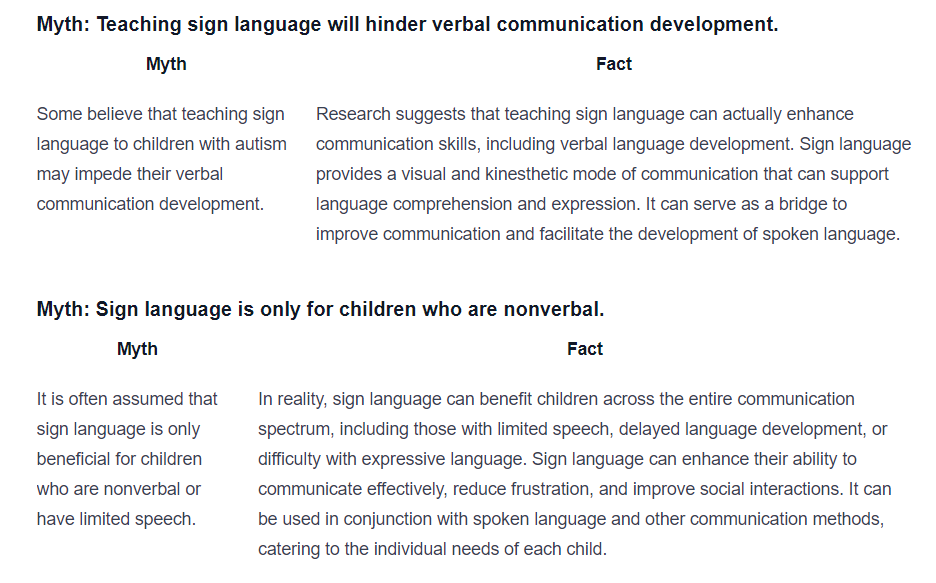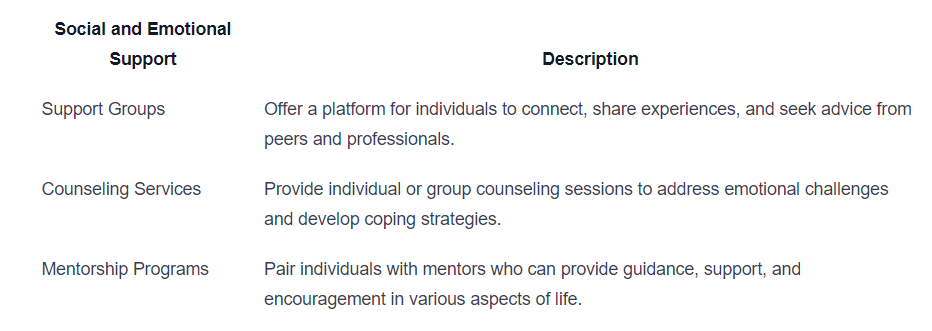Should We Teach Children with Autism Sign Language?
Breaking barriers for autistic children's communication! Explore the impact of sign language and debunking myths. Should we teach children with autism sign language?

Understanding Autism and Communication
For individuals with autism, communication can present unique challenges. Understanding these challenges and the importance of early intervention is crucial in supporting their development and enhancing their communication skills.
Communication Challenges in Autism
Autism spectrum disorder (ASD) is characterized by difficulties in social interaction, communication, and language skills. These challenges can vary widely among individuals with autism, ranging from mild to severe. Some common communication challenges include:
- Delayed language development: Many children with autism experience delays in speech and language acquisition. They may have difficulty expressing themselves verbally or understanding spoken language.
- Nonverbal communication difficulties: Some individuals with autism may struggle with nonverbal communication cues such as facial expressions, gestures, and body language. This can impact their ability to interpret and convey social information effectively.
- Social communication deficits: People with autism may have difficulty engaging in reciprocal conversations or understanding the nuances of social interactions. They may struggle with turn-taking, maintaining eye contact, or grasping social subtleties.
Importance of Early Intervention
Early intervention plays a critical role in supporting the communication development of children with autism. By identifying communication challenges early on and providing appropriate interventions, we can help minimize potential communication barriers and enhance their overall quality of life.
Research has shown that early intervention can lead to significant improvements in communication skills for children with autism. It can help promote language development, increase social interaction, and improve overall communication abilities. Early interventions may include speech therapy, behavioral interventions, and augmentative and alternative communication (AAC) approaches.
It is important to note that while sign language is one of the AAC approaches, it may not be suitable or effective for every individual with autism. The decision to teach sign language should be based on an individualized assessment of their needs, preferences, and abilities.
By understanding the communication challenges faced by individuals with autism and the importance of early intervention, we can work towards providing appropriate support and interventions to enhance their communication skills and overall well-being.
Sign Language for Autistic Children
Sign language has proven to be a valuable tool in facilitating communication for children with autism. Teaching sign language to autistic children can have numerous benefits and a positive impact on their overall communication skills.
Benefits of Teaching Sign Language
Teaching sign language to children with autism offers several advantages, including:
- Enhanced Communication: Sign language provides an alternative means of communication for children with limited verbal skills. It allows them to express their thoughts, needs, and emotions more effectively, reducing frustration and promoting self-expression.
- Improved Comprehension: Learning sign language can enhance the understanding of spoken language and improve cognitive skills in children with autism. It helps them make connections between visual and verbal cues, leading to better comprehension of language.
- Building Social Connections: Sign language can facilitate social interactions by enabling children with autism to engage in conversations with peers, family members, and educators. It creates a shared language and promotes inclusivity by bridging communication gaps.
- Reduced Challenging Behaviors: Communication difficulties often contribute to challenging behaviors in children with autism. By providing a means to communicate their needs and desires, sign language can help reduce frustration and minimize the occurrence of disruptive behaviors.
Potential Impact on Communication Skills
Introducing sign language to autistic children can have a profound impact on their communication skills. Some potential effects include:

It's important to note that sign language should not replace other forms of communication or therapies. Instead, it should be considered as a valuable supplement that can support and enhance the overall communication skills of children with autism. Individualized approaches and consideration of each child's unique needs are essential when incorporating sign language into their communication strategies.
Considerations for Teaching Sign Language
When it comes to teaching sign language to children with autism, there are certain considerations to keep in mind to ensure an effective and individualized approach. By tailoring the teaching method and integrating sign language with other communication methods, we can maximize the benefits for these children.
Individualized Approach
Every child with autism is unique, and their communication needs and abilities may vary. Therefore, it is crucial to take an individualized approach when teaching sign language. This involves assessing the child's current communication skills, preferences, and learning style.
By understanding the child's strengths and challenges, educators and parents can adapt the teaching methods to suit their specific needs. Some children with autism may benefit from a more visual approach, while others may respond better to tactile or auditory cues. It's important to be flexible and patient, allowing the child to progress at their own pace.
Integration with Other Communication Methods
While sign language can be a powerful tool for enhancing communication skills in autistic children, it is essential to integrate it with other modes of communication. This can include spoken language, visual aids, and assistive technology. By combining different methods, we provide the child with a variety of ways to express themselves and understand others.
The integration of sign language with other communication methods allows for a comprehensive and holistic approach to communication. It supports the child in developing a range of skills and strategies to effectively interact with others in different contexts. It's important to collaborate with speech therapists, educators, and other professionals to create an integrated communication plan that addresses the specific needs of each child.
By adopting an individualized approach and integrating sign language with other communication methods, we can create a supportive and inclusive environment for children with autism. This approach recognizes the unique communication challenges they face and empowers them with the tools and strategies needed to express themselves and connect with others.
Myths and Facts about Sign Language and Autism
When it comes to teaching sign language to children with autism, there are various misconceptions and myths that need to be addressed. It's essential to separate fact from fiction to make informed decisions about communication strategies. Let's explore some common misconceptions and highlight evidence-based practices surrounding sign language and autism.
Addressing Common Misconceptions


When it comes to incorporating sign language in the communication journey of children with autism, evidence-based practices are essential. These practices are grounded in scientific research and have demonstrated positive outcomes for individuals with autism.
Evidence-Based Practices
- Early intervention: Introducing sign language at an early age can significantly impact communication development in children with autism. Early intervention programs that incorporate sign language have shown positive results in promoting language acquisition and reducing communication challenges.
- Individualized approach: Each child with autism is unique, and their communication needs vary. It is crucial to tailor sign language instruction to the individual's strengths, preferences, and communication goals. An individualized approach ensures that the child receives the most effective support for their specific needs.
- Integration with other communication methods: Sign language should be integrated with other communication methods, such as speech therapy, visual supports, and augmentative and alternative communication (AAC) systems. Combining multiple modalities allows for a comprehensive and flexible communication system that best suits the child's abilities and preferences.
By dispelling common myths and embracing evidence-based practices, we can recognize the value of sign language as a communication tool for children with autism. Sign language can enhance their communication skills, foster social connections, and empower them to express their thoughts and feelings effectively.
Implementing Sign Language in Daily Life
When it comes to incorporating sign language into the daily life of children with autism, parents and caregivers play a crucial role. By adopting effective strategies and utilizing the available support systems and resources, they can create a conducive environment for the development and utilization of sign language as a communication tool.
Strategies for Parents and Caregivers
Parents and caregivers can implement various strategies to promote the use and understanding of sign language in daily life. Some effective approaches include:
- Consistency: Consistency is key when teaching sign language to children with autism. Establish a routine where sign language is consistently used in daily interactions. This helps children associate signs with specific words or actions, facilitating their communication skills.
- Visual Supports: Incorporate visual supports, such as visual schedules, charts, or flashcards, to reinforce the use of sign language. Visual aids can enhance comprehension and serve as reminders for both the child and the caregiver.
- Modeling: Act as a role model by using sign language regularly. When speaking, accompany your words with the corresponding signs. This visual demonstration helps children understand the connection between signs and spoken language.
- Repetition and Reinforcement: Practice signs repeatedly and reinforce their use with positive reinforcement, such as praise or rewards. Repetition helps children with autism grasp the meaning and application of signs, enabling them to communicate more effectively.
- Incorporate Interests: Integrate the child's interests and preferences into sign language learning. For example, if the child loves animals, focus on teaching signs for different animals. This personalization enhances engagement and motivation.
Support Systems and Resources
Parents and caregivers of children with autism can benefit from various support systems and resources to facilitate the effective implementation of sign language. These include:

By implementing these strategies and utilizing the available support systems and resources, parents and caregivers can create an environment that fosters the successful integration of sign language into the daily lives of children with autism. This, in turn, enhances their communication abilities and promotes meaningful interactions with others.
Looking Towards the Future
As we continue to explore the impact of sign language on communication for children with autism, it is important to consider the future of this approach. By promoting inclusivity and advancing research, we can create a more supportive environment for individuals with autism.
Promoting Inclusivity and Communication
One of the key goals moving forward is to promote inclusivity and ensure that individuals with autism have equal access to communication tools and resources. By recognizing the benefits of teaching sign language to children with autism, we can work towards integrating sign language into educational settings and community programs. This not only enhances communication for individuals with autism but also fosters a more inclusive society that embraces diverse forms of communication.
Furthermore, promoting inclusivity involves raising awareness and understanding about autism and sign language. Educating the general public and debunking misconceptions can help create a more accepting and supportive environment for individuals with autism who use sign language as a communication tool.
Continued Research and Advancements
While there is already evidence supporting the benefits of sign language for autistic children, continued research is necessary to expand our understanding and refine our approaches. Ongoing studies can provide further insights into the specific ways sign language impacts communication skills, social interactions, and overall well-being in children with autism.
Advancements in technology also hold promise for the future of sign language and autism. With the development of innovative tools and applications, we can create interactive learning experiences that facilitate the acquisition and practice of sign language for children with autism. These technological advancements can enhance engagement, motivation, and progress in their communication journey.
By investing in research and embracing technological advancements, we can ensure that sign language remains an effective and evolving tool for supporting the communication needs of children with autism.
Looking towards the future, it is crucial to prioritize inclusivity and further our understanding of the impact of sign language on the lives of individuals with autism. By promoting acceptance, advancing research, and embracing technological advancements, we can create a more inclusive and communicative society for all.
Sources
https://www.abtaba.com/blog/sign-language-for-autism
https://www.healisautism.com/post/teach-children-autism-sign-language
https://www.autismparentingmagazine.com/autistic-child-sign-language/
Similar articles
We’re here to help you

Our team is here to assist you in this process. Contact us for any assistance.
it’s easy to apply
We Accept Most Insurances
Our in-network insurance partnerships make ABA therapy more accessible to families throughout our service areas.







Our Insurance Process
We'll request your insurance details to help us verify your plan's coverage for ABA therapy. Once we've received this information, we'll walk you through your benefits, including copayments, deductibles and out-of-pocket maximums, so you know what to expect in advance.
Our team will then handle the preauthorization and all the necessary paperwork.
.svg)





















.jpeg)


































.jpeg)




.jpeg)







.jpeg)











.jpeg)
















